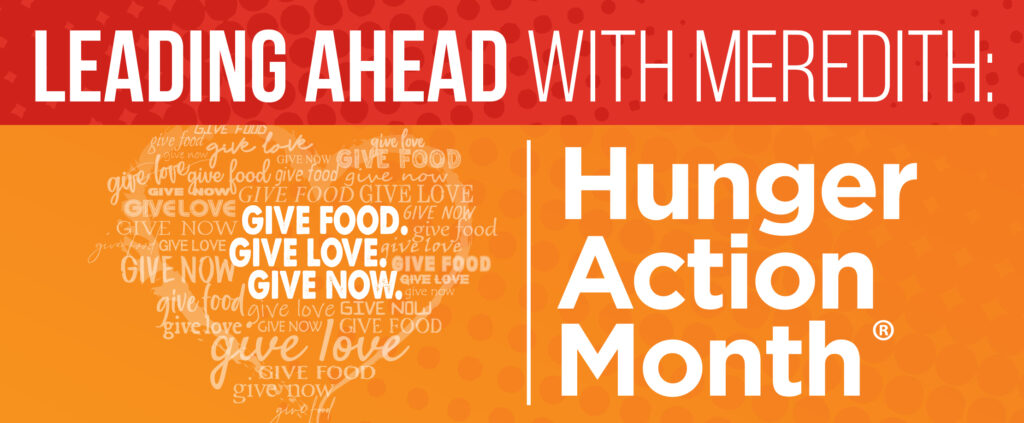Frank Finnegan joined the St. Louis Area Foodbank as executive director in 1989.

Today, 25 years later, he continues to lead this remarkable nonprofit toward its goal of alleviating hunger in the bi-state region.
This brief interview offers insight from Finnegan on his role at the Foodbank and his ideas for the future.
What initially inspired you to work for a hunger relief organization?
The money. (Laughter).
I was working at the United Way at the time and the Foodbank was in search of an executive director. I knew a few people on the board of directors at the Foodbank, so I threw my hat in. It all just fell into place.
I had worked at a number of nonprofits before but not necessarily at one that provided food assistance. I really liked the opportunity it provided. I liked that the Foodbank’s impact was relatively large, but at the same time we weren’t working directly with clients.
As executive director, and now as CEO and president, I was and am one step removed, so I don’t have those personal stories about Mrs. Smith and her kids.
I had those stories when I worked in direct service and I couldn’t leave them at work. I’d take them home. I knew I couldn’t do that for the rest of my life.
That’s what was appealing about the Foodbank. It provides a very valuable service, it’s in the field of social services, and yet, it’s not on the front line.
I liked that we could provide support and services to those who would be on the front lines.
When you started at the Foodbank, did you see yourself staying here long-term?
No. When I took the job I hadn’t been any place for longer than three or four years. So I thought I’d be here for about five years and then I’d move on. I’d stay in social services but do something else.
Well, the first five years went by very, very fast and I really enjoyed what I was doing. It gave me a lot of personal satisfaction.
I saw the organization grow during that period, and I felt good about the impact we were having in the community. I really enjoyed working with the board and the support I received. There was no need to look around. I was sure I wouldn’t find anything that would make me as happy as where I was.
The next five years went by really fast, and I’d been here 10 years. At that point I knew that windows of opportunity might be closing. I looked around a little, but decided that I really enjoyed what I was doing. I recommitted to staying at the Foodbank.
And now I’ve been here for 25 years!
What is the biggest change you have seen over the years in the fight against domestic hunger?
Twenty-five years ago, it was really much more of an emergency program. We’d provide food to pantries, soup kitchens and shelters that were serving families for a short period of time – a month to three or four months – until their crisis had passed.
We don’t see that today. Now, because of the working poor, the increases in prices of utilities and housing, and the stagnation of the growth in salaries, we’re seeing people that are coming every month and it is not going to change. They’re not in need on a short-term basis.
 How has your role at the Foodbank changed your perspectives?
How has your role at the Foodbank changed your perspectives?
I believe that what we do here is very important and I think that we do have an impact on fighting local hunger. I’m very proud of that.
I’ve also come to realize that the private sector and churches and volunteers are not going to end hunger. I think that is going to take a national effort.
As important as what we do is, we can’t make up for cuts to programs like SNAP (Supplemental Nutrition Assistance Program, also known as food stamps.)
SNAP is the largest anti-hunger program in the country. It has the largest impact, and it’s going to take an increase in SNAP to help solve hunger. Instituting universal school breakfast and lunches would go a long way as well.
What is your philosophy on Foodbank management?
Stay out of their way.
The first thing you need to do is recruit talented and energetic people and then lay out a very clear path on where you want to go. Provide the resources so that staff not only knows where we want to go, but have the resources to achieve the end result. Then stay out of their way.
At the same time, you have to have very clear metrics so that you can measure your progress toward that goal. I think it’s my responsibility to provide the direction, the resources and the motivation. It’s the staff’s responsibility to be successful. It’s a marriage of those things.
What is your vision for the future of the St. Louis Area Foodbank?
I would want it to continually be an integral part of the community.
Right now, we have 20,000 people who come out and volunteer. We have hundreds of food drives throughout the year. We have great support on our board from local corporations and we’re relatively well known within the community.
In that sense, we offer a meeting place for people of various political views and differing ideas to come together and unite to eradicate this one problem.
That’s what I want the Foodbank to continue to be.
By Bethany Prange
St. Louis Area Foodbank Social Media Specialist

